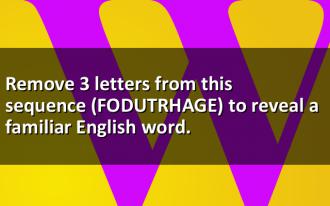Remove 3 letters from this seq...
Remove 3 letters from this sequence (FODUTRHAGE) to reveal a familiar English word.Correct answers: 59
The first user who solved this task is Thinh Ddh.
#brainteasers #wordpuzzles

Conway Twitty, Is That Really You?
A young pastor moved to town and decided he would go around and introduce himself to the new congregation. He rang the first door bell and a lady came to the door. She stared at him as he introduced himself.
She said, “I can't believe how much you look like Conway Twitty, the country music singer.”
He replied, “Yes, ma’am, I hear that a lot.”
He went to the next house and the next, and every lady that came to the door said the same thing—that he looked like Conway Twitty.
At the last house, a shapely young lady came to the door with a towel around her. He started to introduce himself, but she loosened her towel, threw her arms in the air, and screamed, “Conway Twitty!”
The pastor stood there, stunned. Then he said, “Hello, darling!”

